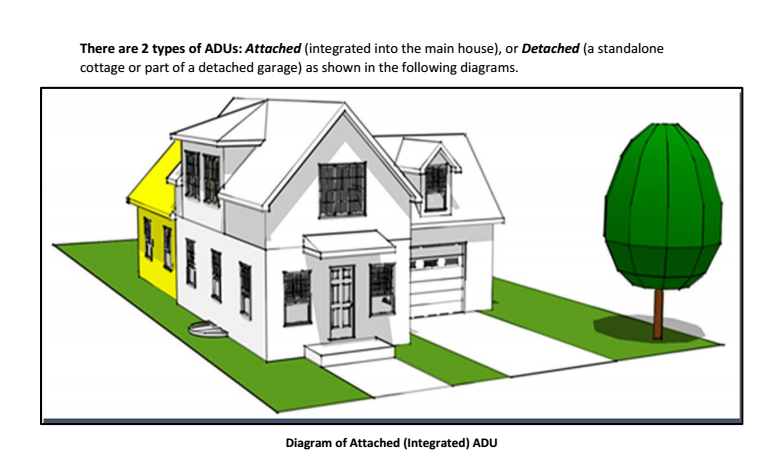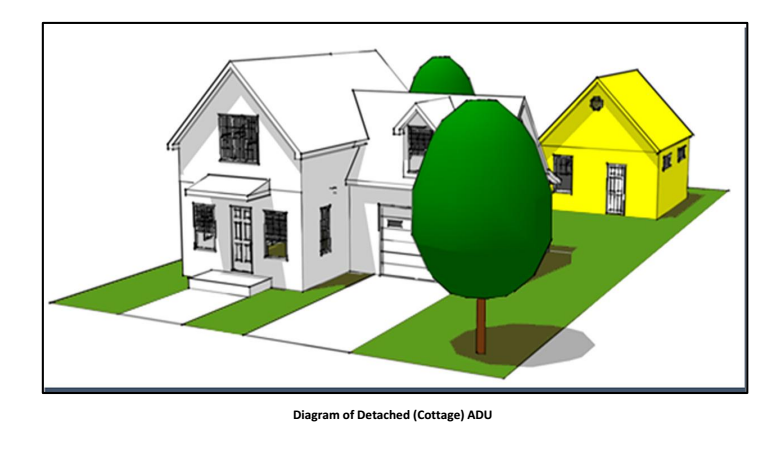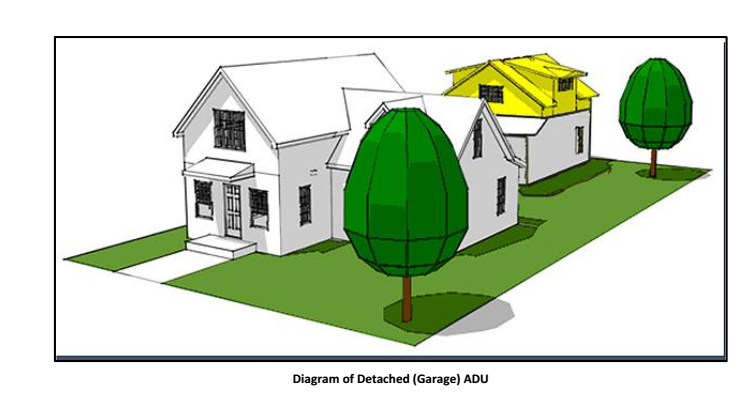What is an ADU?
Posted in: Learning Center
HISTORY OF THE ADU
In the 1940s and ’50s, many American families rented out an extra apartment over their garages or in the basement of their homes as a way to earn some extra income to help with the mortgage payment or with other household expenses. In fact, backyard cottages and attic and basement apartments were a common feature in many communities across the country. Since then, as more communities have adopted restrictive residential zoning regulations, such apartments, technically known as accessory dwelling units (ADUs), have been either severely limited or banned altogether, usually in the name of protecting single-family neighborhoods.
Recently, however, perceptions and attitudes toward accessory dwelling units are once again beginning to change. Much of this transformation can be attributed to the effects of the affordable housing crisis as well as the growing numbers of smaller households. In addition, new growth management laws are requiring many communities to plan for and accommodate higher housing densities.
Against this backdrop, many communities in Washington have begun to reexamine the appropriateness of zoning regulations that severely limit or prohibit accessory dwelling units. Accessory dwelling units have emerged as an important component of the affordable housing strategies being carried out in many Washington cities. For cities over 20,000 in population, the Washington State Legislature has now mandated that accessory dwelling units be encouraged and allowed in single-family zones. As a result, many Washington State home builders are being inundated with requests for ADU floor plans that are attractive, and yet affordable housing.
WHAT IS AN ADU?
An Accessory Dwelling Unit (abbreviated ADU) is a secondary living unit built on a parcel of land with another primary home, with its own kitchen, bathroom and sleeping facilities. ADUs are typically smaller than the primary dwelling-most jurisdictions limit them to between 800 and 1250 square feet of living space. This varies by jurisdiction of both cities and counties.
ADUs have also been referred to as “mother-in-law apartments”, “accessory apartments”, “garage apartments”, “rental units” or “second units” depending on their design and purpose.
Subject to local regulations, ADUs may be located either inside, attached to, or detached from the primary home on your property. To be considered attached, living space of both the primary and accessory dwelling units must abut (be on opposite sides of the same wall). Incidental and accessory features such as trellises, decks, patios, breezeways, garages or tool sheds do not generally establish an attached structure.
There are a variety of standards which may be applied in the case of an ADU. These might include limiting the overall number of residents in both units, limitation with respect to home occupations, the location of entrance doors and size of the ADU. Where an ADU is created in a new or existing detached structure or by the addition to a house, there are additional standards regulating the exterior appearance and materials of the ADU. These additional standards include provisions for the height, roof pitch, trim, eaves and windows. Your local building department can provide additional guidelines that should be followed.
WHO CAN BENEFIT FROM AN ADU?
Many municipalities now encourage homeowners to build Accessory Dwellings on properties with single family homes. There are many restrictions that apply, however; there is a reasonable amount of flexibility that allows most homeowners to add ADUs on their property. Also, in many cases, the homes do not have to be owner occupied.
ADUs provide a surprising number of benefits to communities, homeowners and renters.
- Financial Benefit to Tenant: ADUs can be rented for reasonable rents since construction costs are less than conventional homes. Also, ADUs offer housing opportunities in more desirable single-family neighborhoods for some that might not be otherwise be able to afford to live there. Living in an ADU would give these households the opportunity to enjoy the amenities typically found in many single-family neighborhoods, including more privacy, a quieter environment, and less traffic congestion.
- Financial Benefit to Homeowner: ADUs can provide homeowners with extra income to help meet rising home ownership costs. ADUs can provide many homeowners with needed additional income to meet high mortgage and maintenance costs. This can help young families or single parents, as well as additional income for elderly homeowners who are living on fixed incomes.
- Assisting Family Members: Another advantage of an ADU is for providing needed housing for family members. Some parents will provide and ADU for young adult family members and young couples who are just getting started. Elderly family members can avoid both the emotional and financial costs of having to move into a nursing home. Another possible option to assist the elderly is for the elderly homeowner to build and move into the ADU and rent out the main house to relatives or the public. This scenario allows the elderly homeowners to live their lives out on their property without the expense and maintenance of the larger home.
- Increased Property Value: The addition of an ADU can increase the current and resale value of the property significantly above the initial cost of the ADU. A secondary rental unit or “guest house” can be very attractive to potential buyers. Also, if financed through a mortgage on the property, the interest payments and some of the closing costs are usually tax deductible.
- Tax Benefits: Homeowners can apply a portion of the rental income to maintaining their property. So, ADUs can encourage better upkeep of existing housing.
Allowing the development of accessory dwelling units, or ADUs, in single-family homes is becoming an increasingly popular technique for creating low- and moderate-income housing for both homeowners and renters. Homeowners benefit from the additional rental income that they can use to pay part of their mortgage payment or to help with the upkeep on their homes. Renters benefit from the availability of moderately priced rental housing in single-family neighborhoods. The community benefits from the addition of affordable housing for little or no public expense.
With three offices in Tacoma, Tri-cities and Spokane, True Built Home has been successfully helping families create their dream homes across the state of Washington. As a home builder with years of experience, we have developed an easy, step-by-step process for you to find and create the home you’ve always wanted at an affordable and reasonable price. Our specialty is in pre-designed efficiently built homes as an alternative to either manufactured or modular homes. We are built 100% on your site. Additionally, we have taken the time to equip our web site with lots of helpful information and tools you can use to carefully plan and begin to understand the process of new home construction.
If you’re thinking about moving into your dream home or have any questions, please give us a call. Our friendly staff of experienced home builders is ready to help you. Call us in our Tacoma office at 253-272-5300, Tri Cities at 509-783-1411 or Spokane at 509-255-3939. If you are unsure if we service your area, please check out our following service pages for more details.


